| "Seized in Beirut - The Plundered Archives of the Palestinian Cinema Institution", Anthropology of The Middle Eastl 12 (2), 2017 | | | | To purchase the book in Arabic (2018, published by Madar Center, Ramallah - an expended and updated version) | | | | To purchase the book (in Hebew, 2009) | | | | Ismail Shammout - The Urgent Call of Palestine (1973) | | | | After Looted & Hidden: The Urgent Call of Palestine - An Interview with Zeinab Shaath , Rona Sela (Director, 2018) | | | | Return of Palestinian Archives, Images and Items to their Original Owners- a paper from April 2018 on Academia | | | | "Looted and Hidden - Palestinian Archives in Israel", film, Rona Sela (director, 2017) | | | | New (in English): "The Genealogy of Colonial Plunder and Erasure – Israel's Control over Palestinian Archives", Social Semiotics, 2017 | | |
To view the second (visual) volume in Hebrew
=_blank class=contentLink>The text in MY web site
Key words: Looting, taken as booty, seizure, Palestinian Archives, Palestinian historiography, censorship, archive control, surveillance, "Village Files", ''infiltrators'', Orient House Archive, Palestine Research Center, "PLO Archive", Ali Za'arur, Chalil Rissas (Khalil Rassas) , Palmach Squadron together with the Technical Department,Patrols of the Palmach/Technical Department, Israel Netach - spy photographer | | | | Abstract | | | The exhibition and the book (in Hebrew) Made Public summarize three years of research in military photography archives in Israel and focus on two key subjects each involving the other: the manner in which military systems loot/seize collect, control and release (or censor) photographic information about the Palestinians- in the past and over the years - and the missing chapters of Palestinian visual historiography.
The military photographic information is based on a multiplicity of power relations, from the way in which information was collected by force by army units, organizations or other archives (plunder and looting, for example the Palestine Research Center that was taken as booty in Beirut by Israeli soldiers in 1982, or the Orient House Archive in Jerusalem plundered in 2001 by the Israeli Police and reflects the same strategy; secret and forbidden duplicating of material from various archives; and intelligence gathering and surveillance by various means such as the "Village Filds") to the way the archives are managed (censorship and restricted viewing and use) and how certain materials are not revealed to the public.
Made Public discusses the IDF archive policy, which controls the information released to researchers, decides which research is to be conducted and the data it’s based on, and obstructs and prevents access to specific material. These actions join those of intelligence and secret service agency archives worldwide as shown by Hughes R. Gerald and Scott Len (2008). Since my research deals with the representation of Palestinians in Israeli military archives, it raises additional issues, such as the way archives control the release of information about the Palestinians, information that has importance in forming, establishing and building national identity and collective memory. The IDF archive, thus, not only controls the distribution of information, the writing of Israeli history, legacy and culture, but also controls research on Palestinian history and how this impact the building of a Palestinian national identity based on national memory.
The military archives in Israel preserve the archives of the pre- state military bodies and the information regarding their activities, as well as those of the different Israel Defence Forces (IDF) units of the state that made use of photography.The different military units collected data regarding the Palestinians as part of information gathering and surveillance for a variety of military and operational objectives. The military archives also hold information on military subjects received from individuals and private organisations, mainly looted material or information achieved by force in various ways, thereby accumulating visual and textual material relating to the Palestinians with whom the State of Israel is in a national conflict. Made Public, thus examines the collection of photographs and archives of Palestinians and about Palestinians controlled by military photography archives, and their use. It documents the way military bodies and archives, including military photography archives subordinate to them, take by force, loot and hold information regarding the Palestinians, seize their cultural property and control their distribution in the public realm. The exhibition and the book trace how, through force, photography archives and photographs of Palestinians and about Palestinians in military archives were taken as booty or gathered, and follow the activity of organisations that seized and collected information about the Palestinians. Since the material available for study in military archives is restricted, censored, and controlled by the archive and its stringent laws, the little I was authorized to research and use deals mainly with Palestinian existence up until the first half of the twentieth century, suggesting that it is only part of the Palestinian material in military archives.
Since its establishment, documentation of all types that were produced in different IDF units was transferred to the IDF and Ministry of Defence archive – records, audio tapes, video tapes, photographs, maps, sketches and the like. The IDF archive became the largest existing center of information in Israel for subjects connected to the army and security. The photography collection of the IDF archive, like its other collections, are subject to the authority of the general policies of the archive, according to which it releases photographs for public view and use only after security restrictions have been lifted and they have passed censorship. Although collecting and holding information concerning the Palestinians and the Arab states is not one of the aims of the archives, the army gathers a great deal of data about them as part of the information activities of military units. The way in which visual information on the Palestinians is taken by force and gathered in the military archives of Israel, the extent of the material and the implications of its assembly has until today not been researched, this being the first study dedicated to the subject.
The military photography archives in Israel hold photographs concerning the Palestinians that arrived from two main sources– the first, photographs from military organizations, intelligence bodies and others, who actively initiated the collection (by force) of visual information mainly for military intelligence purposes. The information was gathered, for example, in the following ways: through controlled confiscation and plunder, initiated by pre-state and state military bodies, of archives and Palestinian collections and photographs, from organizations or Palestinian sources, or via copying of secret information relating to the Palestinian population from British archives and sources during the period of the British Mandate. At the same time, the military organizations of this period initiated the gathering of intelligence information – visual and textual- regarding Palestinian villages and cities (“Village Files” and Textual “Surveys” of Palestinian Villages and Towns), the Palestinian population and individuals who participated in the national resistance, with the idea that as much information available about the Palestinians as possible would make it easier to confront them in future national conflicts. This information was gathered by Jewish scouts, soldiers or pilots. After the founding of the state, visual (photographic) material concerning the remaining Palestinian population in the country was collected by the intelligence services for the purpose of control and surveillance, while military organizations dealing with documentation, propaganda and public relations, documented various Palestinian themes for Zionist-military purposes. These bodies hold photographs that make it possible to chart the fracturing of the Palestinian population as a result of the Nakba (the catastrophe, 1948), though they were not taken for this reason. The second method used by military archives to obtain photographs of the Palestinians was via donations over the years from civilian bodies, private individuals and soldiers, mainly plunder photographs.
The research also focuses on the methodology of the military photography archive offshoots subject to the IDF archive, its laws and regulations and this information is attached to the title of the photographs. Made Public thus studies the army’s archive as a central body controlling other army archives, its standards and ethics, how it functions, its role, the central strategies behind its policies and the laws it utilizes. The exhibition and the book seek to expose the mechanisms of power that built and operated the archive, the systems that serve it today, the practices at its base and the oppressive manner in which it reveals or precludes information from the public. They deal however, only with photographs of the Palestinian population, Palestinian existence, or Palestinian sources up until the middle of the 1950s, and the Nakba– that is with materials that were available to me. Yet it seeks to describe through them the way these archives, military bodies, soldiers but also citizens operate, a reflection of the Israeli society.
The Nakba led to the destruction of Palestinian existence and culture. Many Palestinian archives disappeared, were destroyed or looted as a result of the war and its implications and as a result of other wars in the region (1967, 1982 etc.). Photographic information of Palestinians and about Palestinians in military archives in Israel as revealed in the book and the exhibition expose some of the material that was lost. Made Public uncovers, for the first time, photographs dealing with the Palestinian population and Palestine in the first half of the twentieth century photographed by both Jewish, Palestinian, Arab or foreign photographers, professional and amateur photographers, and stored in military archives. It allows, therefore, partial completion of missing chapters of Palestinian visual history (Sela 2007) and a presentation of Palestine before 1948 and the extreme change that began in the country following the rift of the 1948 war. The book and the exhibition assemble all existing information that was not restricted concerning the Palestinians that are today in military archives, and makes it possible to trace unknown scenes of Palestine and of Palestinians in the first half of the twentieth century that were precluded from viewing by both Israeli and Palestinian researchers. They reveal life in Palestine before 1948: Palestinian personages; individuals who took an active role, political and military; the massive Palestinian uprising; the armed Palestinian resistance from 1933 until 1948; the Palestinian towns and villages and the Palestinian way of life pre 1948. In addition, the book and the exhibition devote a section to a description of the 1948 refugees and the extreme change experienced by the Palestinian population and the country beginning after the Nakba, which the Israeli army documented.
The book and the exhibition exposes photographs dealing with the Palestinian population and Palestine in the first half of the twentieth century photographed by both Jewish, Palestinian or Arab photographers, professional and amateur photographers, and stored in military archives. It thus allows partial completion of missing chapters of Palestinian visual history and a presentation of Palestine before 1948 and the change set in motion in the country following the rift of the Nakba. The book and the exhibition assembles all existing information that was not restricted concerning the Palestinians that are today in military archives, and makes it possible to trace unknown scenes of Palestine and of Palestinians in the first half of the twentieth century that were precluded from viewing by Israeli and Palestinian researchers. Because of archive restrictions, only photographs of Palestinians and about Palestinians up until the mid- 1950s were released from the archives, although later photographs are existed in the archives.
The exhibition deals with the following subjects:
1. Palestine on the eve of the First World War – American Colony photographers
2. Pre-military deployment, national organizing and uprisings in the public arena
– various photographers
3. Military resistance– various photographers
4. Photography for gathering intelligence in Palestinian villages prior to 1948 –
Jewish photographers
5. The Palestinian villages and population after 1948 and the Israeli army – Israeli army photographers
6. Intelligence gathering about individuals prior to and after 1948- "infiltrators" according to Israeli terminology and others – various photographers
Most of the photographs in the book and the exhibition are of a military nature since this is the main focus of military archives. The exhibition and the book reveal only a small part of the total materials discovered in the research and restore them to the Israeli and Palestinian public sphere. Two types of photographs are shown in the exhibition: photographs that reflect the Palestinian viewpoint concerning the founding events in the history of the country, and photographs taken for military, documentary and Zionist objectives. These photographs, although taken for propaganda purposes, enables learning about the Palestinian villages before the Nakba and trace the map of the country prior to the State of Israel’s establishment, and therefore they are important, culturally and historically.
The exhibition is supported by Israel Lottery the Council for the Arts, and an anonymous donor.
| | | | Alittihad, 15.09.2009 (Arabic) | | | | The Guardian 17.09.2009 - photographs | | | | Elaph, 30.09.2009 (Arabic) | | | | Symposium, Jeu de Paume, Paris, January 2011 | | | | Haaretz Supplement, English edition, 21/5/2011 | | | | Interview, THe Great Book Robbery, Documentary Film, Benny Brunner (Director), AlJazeera, 2011 | | | | "Rethinking National Archives in Colonial Countries and Zones of Conflict", Ibraaz, Platform 006, January 2014, also published in: Dissonant Archives: Contemporary Visual Culture and Contested Narratives in the Middle East, ed. Anthony Downey, IB Tauris, 2015 | | | | "Scouting Palestinian Territory 1940-1948: Haganah Village Files, Aerial Photos and Surveys", in Jerusalem Quarterly 52, Salim Tamari and Issam Nassar (eds.), Winter 2013 | | | | Haaretz, January 31, 2022 | | |
| | | | 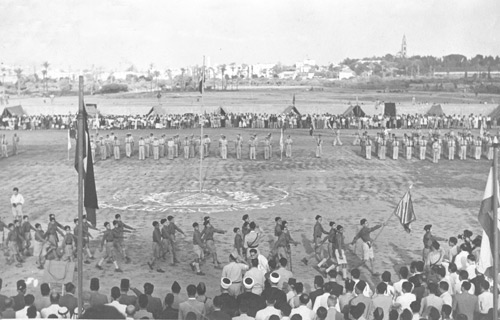 | | Unknown photographer, Palestinian Event in Batsa Stadium in Jaffa (today Blummfield), 1940s,
Looted photograph taken from the office of Rashid Haj Ibrahim, IDF and Ministry of Defense Archive. According to the archive, “since November 2002 an opinion by the attorney general to allow the use of
seized material in these archive files” is in effect
| | | 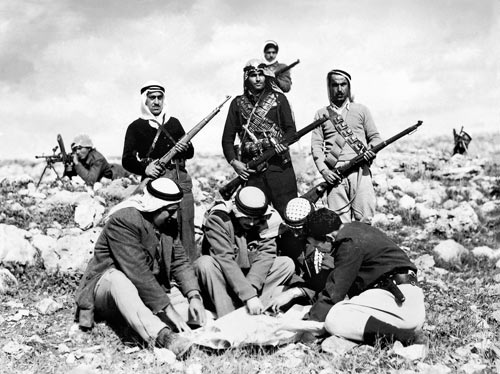 | | Chalil Rissas (Khalil Rassas), Abd al-Qadir al-Husayni, Studying Maps with his Aides, among them Kassim al-Rimawi (catalogued in the archive: ''Arab Gangs in Jerusalem Mountains''), 1948, Haganah History Archive. Rissas’s photographs from the Haganah archive were looted from the photographer’s studio by an Israeli officer. | | |  | | Patrols of the Palmach/Technical Department, from the Village File of Hulda, 1947. Israel Defence Force and Ministry of Defense Archive, Intelligence Gathering
The photographs were taken by Jewish soldiers for surveillance and conquest purposes pre-1948 war
The files on Palestinian villages from the IDF Archive “were examined and opened by the Opening
Material Team. Classified g - date opened: 29.2.2001.”
1 - East entrance
2 - East path
IDF and Ministry of Defense Archive
| | | 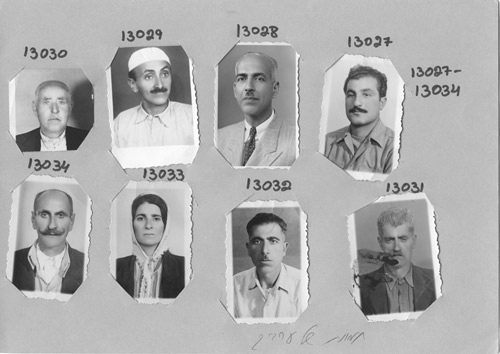 | | Unknown photographers, ''Pictures of Arabs'', approx. 1949-1950, Hagana Archive, The photographs were originally in the files of the Information Service, which apparently dealt with Palestinians desiring repatriation to their homes and lands in Israel after the 1948 war, ''infiltrators'' according to Israeli terminology. The contents of the files were reorganized by the archive in the 1990s. The structure and extent of the original files is not known
| | | 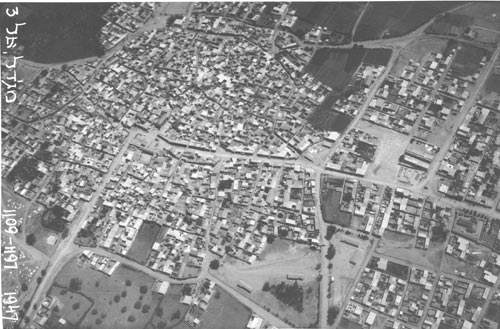 | | Palmach Squadron together with the Technical Department, AlMajdal (after 1948 was populated by Israelis, today Ashqelon), 1947
Aerial Photograph, Map
The photograph was taken for surveillance and conquest purposes pre 1948 war
| | | 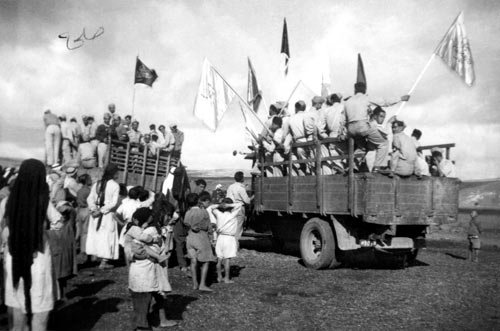 | | Unknown photographer, Al-Najda Organization in the village Zalcha, late 1947
Material looted from the office of Rashid Haj Ibrahim, Head of the National Committee, Haifa
IDF and Ministry of Defense Archive
According to the archive, “since November 2002 an opinion by the attorney general to allow the use of seized material in archive files” is in effect.
| | | 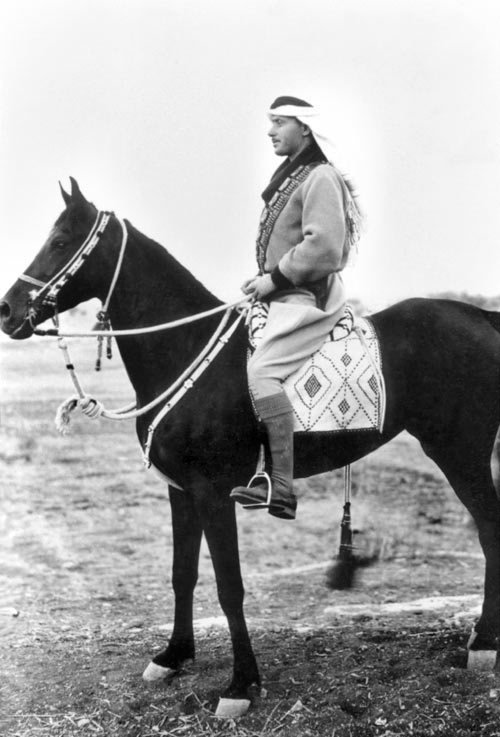 | | Unknown photographer, Al-Qawuqji, Top Commanding Officer of the Palestinians, 1936, Palmach Archive, the photograph was seized/looted for intelligence purposes and donated to the archive by an Israeli intelligence soldier. | | | 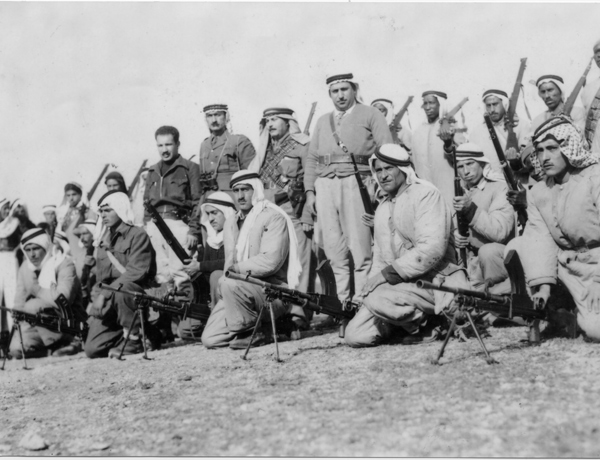 | | Israel Netach, photographer disguised as an Arab in order to gather intelligence (spy photographer), Abdal-Qadir al-Husayni before going up to Gush Etzion, Palmach Archive
| | |
|